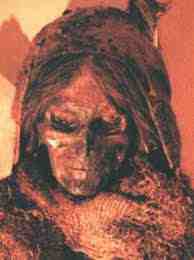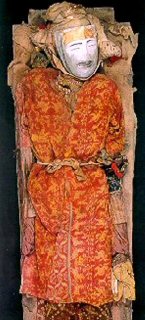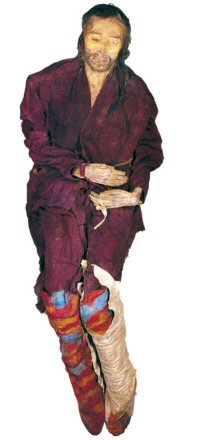New York Times Report
http://www.nytimes.com/2010/03/16/science/16archeo.html?pagewanted=all&_r=0
Travel info
http://wikitravel.org/en/Cherchen
Dna
https://culturalandscape.wordpress.com/tag/european/
Article below
http://www.mummytombs.com/mummylocator/group/urumchi.htm
also called Ürümchi mummies, Tarim mummies, Tarim Basin mummies, Cherchen mummies, Loulan mummies, Taklimakan Desert mummies, Lopnur mummies, Qumul mummies, Turpan mummies
When were they made
|
Dating as far back as 4,000 years, they were made by accident--naturally--by the dry climate in the salty Tarim basin. The oldest mummies from Cherchen found so far died about 3,000 years ago, while the oldest mummies found near Loulan died about 4,000 years ago.
How were they made
|
Bodies buried in the sandy desert (most likely in winter) froze (or at least got very cold quite quickly) and dried out before they could begin to rot. By the time summer (and high temperatures) arrived, the bodies had become mummified. Because they were already dried, the summer's heat would not cause them to deteriorate.
These bodies were placed in bottomless coffins which allowed good air circulation--this enabled the body to dry out completely. (Other nearby bodies, most likely buried when the temperature wasn't cold, turned into skeletons.)The composition of the soil (high in salt) speeded the drying out process, since the salt sucked the moisture from the atmosphere (and the bodies).
How many were made
|
The Cherchen mummies include Cherchen Man (called the man with ten hats by Elizabeth Wayland Barber), Cherchen Woman, two other women, and an infant wrapped in a beautiful brown cloth tied with red and blue cord. The infant was buried with a "baby bottle" made from a sheep's udder; each of its eyes was covered with a blue stone.
The Loulan mummies (actually from Qäwrighul near the town of Loulan) include the Beauty of Loulan and a few other mummies including an eight-year-old child wrapped in a piece of patterned wool cloth and closed with bone pegs. The wool clothing from Loulan seems to be much less colorful (in much more neutral, earth-tone colors--though fading could have occurred), but it is no less impressive in its patterns and weaves.Scientists believe that many more naturally mummified bodies may be found in the area.
What's special about them
|
The Cherchen mummies are known for their degree of preservation (far better than most Egyptian mummies), their colorful clothing, and their Caucasian features. Their burial fabrics (in unusual patterns and woven in unusual ways) and their Caucasian features suggest that they (and/or their ancestors) had come from Celtic tribes in Central Europe. Why had they ended up in China? Were they nomads? Were they adventurers? Were they raiders and robbers?
| Where to see them |
The Cherchen and Loulan mummies are exhibited at the Provincial Museum of Ürümchi.
http://www.ancient-wisdom.co.uk/chinacherchen.htm
Cherchen Man: (Chärchän man)
The discovery of Cherchen Man, along with dozens of other perfectly preserved mummies found in Turkestan in western China, has made archaeologists question the old perceptions of prehistoric cultural exchange. Although the mummies have been known to exist for decades, no one paid them much attention until 1987 when Victor Mair, professor of Chinese studies at the University of Pennsylvania, began to take interest in them following a visit to an obscure museum in the town of Ürümchi (also spelled Ürümqi). So what were westerners doing in China 3,000 years ago and just how much did they influence Chinese culture.Modern DNA and ancient DNA show that Uighurs, Kazaks, Krygyzs, the peoples of Central Asia are all mixed Caucasian and East Asian (2)
| Cherchen Man: |
Cherchen Man, a 6ft tall Caucasian man was found in a tomb along with three women and a baby in 1978. Their presence raised several important questions such as: What was their lineage, How had they died and more importantly: What were they doing there.A European Origin:The realisation that Cherchen man was Caucasian was a shock to the Chinese establishment who had always maintained that China had remained separate from the west. He was found buried wearing a red twill tunic and tartan leggings (The earliest example of Tartan ever found). Apart from his distinctive Caucasian features, red hair and height, there are several other facts that show he was of western origin. The piles of material buried alongside the corpses were all made of sheep’s wool. As sheep aren’t indigenous to that part of the world, it is presumed that these early travellers must have brought sheep with them from the west. The fabric patterns must have been woven on looms similar to those used to create the scraps she found in eastern Europe. (1) Analysis has shown that the weave of the cloth is the same as that of those found on the bodies of salt miners in Austria from 1,300 BC. (3)
The material, along with other clues such as wheat which was found in other associated tombs, in an area where wheat is not indigenous to the region — was clear evidence that Cherchen Man was a product of Europe. So, too, were less well-preserved mummies of others found throughout the area, some of whom had died 1,000 years earlier.DNA testing confirms that he and hundreds of other mummies found in Xinjiang's Tarim Basin are of European origin. (3)In addition, the burial sites of Cherchen Man and his fellow people were marked with stone structures that look like dolmens from Britain, ringed by round-faced, Celtic figures, or standing stones. Among their icons were figures reminiscent of the sheela-na-gigs, wild females who flaunted their bodies and can still be found in mediaeval churches in Britain. One of the female mummies wears a long, conical hat and was buried with wooden combs now familiar to students of ancient Celtic art. (3)
Unlike other tombs in the area, Cherchen Man’s final resting place was not designed to be reopened, Barber says. He was buried with the three women, one of whom is presumed to be his wife, and the tomb was sealed. A few weeks later, the baby’s body, also well preserved, was placed above the main burial chamber. The baby, about 3 months old, was wrapped in a bright red shroud tied with red and blue cord, then a blue stone placed on each eye. Alongside was a sheep udder fashioned into a nursing bottle. “It is clear that they (other members of the community) tried to keep the baby alive after the mother and father had died,” Barber says, so this wasn’t a case of killing the entire family so all could accompany the man into the next life. None of the mummies show any sign of violence. They apparently died, Barber surmises, from an epidemic. (2)
| The Taklamakan Mummies (Tocharian mummies) |
In the 1980's, hundreds of other perfectly preserved 3,000-4,000 year-old mummies began appearing in the remote Taklamakan desert (which sits on the renowned 'Silk route'). They had long reddish-blond hair, European features and didn't appear to be the ancestors of modern-day Chinese people ."From around 1,800 BC, the earliest mummies in the Tarim Basin were exclusively Caucausoid, or Europoid," said Professor Victor Mair of Pennsylvania University. Altogether there are 400 mummies in various degrees of desiccation and decomposition, including the prominent Han Chinese warrior Zhang Xiong and other Uighur mummies, and thousands of skulls. (3) Their discovery has raised several questions over our understanding of events in the region, particularly in relation to the cultural development of China and our concept of cultural exchange in prehistoric times.
 The Loulan Beauty.
The Loulan Beauty.
Even older than the Cherchen find is that of the 4,000-year-old Loulan Beauty, who has long flowing fair hair and is one of a number of mummies discovered near the town of Loulan. One of these mummies was an eight-year-old child wrapped in a piece of patterned wool cloth, closed with bone pegs. The Loulan Beauty's features are Nordic. She was 45 when she died, and was buried with a basket of food for the next life, including domesticated wheat, combs and a feather.
 Yingpan man:
Yingpan man:
Yingpan Man, a nearly perfectly preserved 2,000-year-old Caucasoid mummy, discovered in 1995 in the region that bears his name, has been seen as the best preserved of all the undisturbed mummies that have so far been found.
Yingpan Man not only had a gold foil death mask - a Greek tradition - covering his blonde bearded face, but also wore elaborate golden embroidered red and maroon wool garments with images of fighting Greeks or Romans. (3)
His nearly 2.00 meter (six-foot, six-inch) long body is the tallest of all the mummies found so far and the clothes and artefacts discovered in the surrounding tombs suggest the highest level of Caucasoid civilization in the ancient Tarim Basin region.
His nearly 2.00 meter (six-foot, six-inch) long body is the tallest of all the mummies found so far and the clothes and artefacts discovered in the surrounding tombs suggest the highest level of Caucasoid civilization in the ancient Tarim Basin region.
扎滚鲁克古墓群景点 Zagunluk Ancient Group Tomb Scenic Spot
Zagunluke Gumuqun Jingdian (zāgǔnlǔkè gǔmùqún jǐngdiǎn)
Zagunluke Gumuqun Jingdian (zāgǔnlǔkè gǔmùqún jǐngdiǎn)
Tel. 0996-792-9001, 30Y. No photos.
09:30-13:30, 16:30-19:30, probably every day. Not staffed -- Go to Toghraklek Manor, just a few kilometers away, to get the docent, who has the key, and bring her/him to the Zaghunluq Tomb building.
09:30-13:30, 16:30-19:30, probably every day. Not staffed -- Go to Toghraklek Manor, just a few kilometers away, to get the docent, who has the key, and bring her/him to the Zaghunluq Tomb building.
 The main tourist attraction in Cherchen / Qiemo is the mummy tomb found in the adjoining village of Zaghunluq. In Chinese guides, it is called 扎滚鲁克古墓群景点, Zagunluke Ancient Group Tomb Scenic Spot.
The main tourist attraction in Cherchen / Qiemo is the mummy tomb found in the adjoining village of Zaghunluq. In Chinese guides, it is called 扎滚鲁克古墓群景点, Zagunluke Ancient Group Tomb Scenic Spot.
On the vast, empty salt plateau, a tiny pink building stands alone. It was built only recently over one of the hundreds of tombs at this site. Excavated only a decade ago, the tombs date back thousands of years. In this 2,600 year old tomb, you can see, a few meters down through the plexiglass cover, fourteen naturally mummified bodies, in their bright woollen clothes with their variety of funerary offerings in excellent condition, looking as if they had been placed quite recently. Several of the mummies are shown in the image to the left, the museum entry ticket.
You can also observe, close up, two 2,400 year old mummies in display cases, a husband and wife that had been buried together in a separate tomb nearby.
Location and Transport
 The Zaghunluq site is less than five kilometers southwest of the city center, passing through rural Cherchen / Qiemo with its poplar-lined lanes, and just 500 m west of the edge of the oasis. You can take a regular taxi, but your driver must pick up the docent with the key at the Toghraklek Manor Museum (above) before going to the site.
The Zaghunluq site is less than five kilometers southwest of the city center, passing through rural Cherchen / Qiemo with its poplar-lined lanes, and just 500 m west of the edge of the oasis. You can take a regular taxi, but your driver must pick up the docent with the key at the Toghraklek Manor Museum (above) before going to the site.
You might want to arrange with your driver in advance for a price that includes him waiting for you as you see the Toghraklek Manor museum, because the museum includes a good selection of artifacts from the excavated graves, and then take you and the docent to Zaghunluq.
Zaghunluq Section Contents
This description and history of the Zaghunluq Cemetery is in a separate page from the Cherchen / Qiemo page due to its length.
Of the following sections in this document, the Location and Transport and The Fascination sections are also included on the main Cherchen / Qiemo page.
Zaghunluq Section Contents
| |
|
|


No comments:
Post a Comment